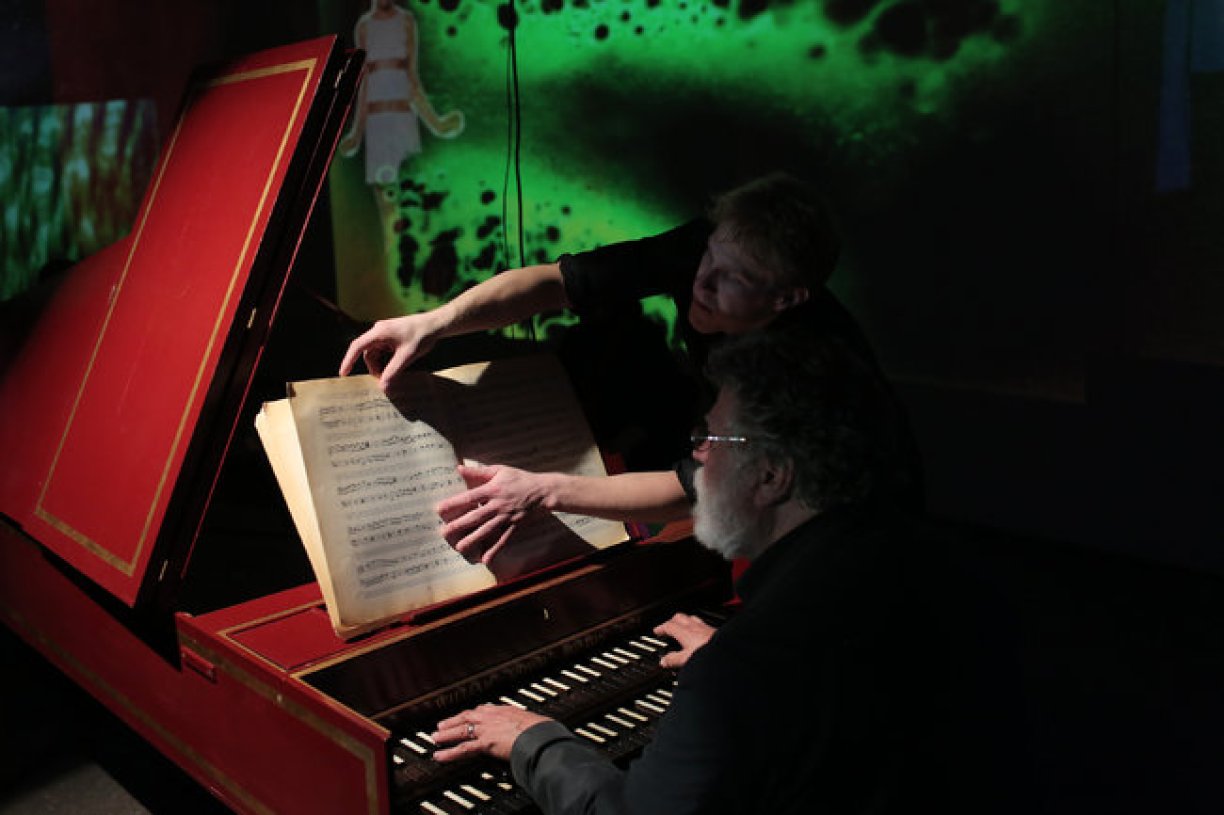An Intentional Spectacle: ‘HPSCHD’ at Eyebeam
Steve Smith in the New York Times
“I hate the harpsichord, it reminds me of a sewing machine,” the composer John Cage is reported to have said. Yet a commission fromAntoinette Vischer, a Swiss harpsichordist who specialized in modern music, prompted Cage to conceive one of his most audacious creations: “HPSCHD,” fashioned in collaboration with another composer, Lejaren Hiller.
A tumultuous spectacle introduced on May 16, 1969, and reflecting the spirit of its age, “HPSCHD” incorporates computer-mutated works by Beethoven, Chopin, Schoenberg and other composers; passages from Mozart’s “Musical Dice Game” (whose chance procedure Cage appreciated); and optional material, accompanied by Hiller’s taped microtonal computer music and a panoply of video artists on site.
Understandably, the elaborate work is seldom revived. But on Friday evening, three institutions — Issue Project Room, the Electronic Music Foundation and Eyebeam Art + Technology Center — collectively mounted an updated version of “HPSCHD” in Eyebeam’s Chelsea gallery. (In a surreal coincidence, an unrelated realization of the work was held the same night at the Cleveland Museum of Art.)
Joel Chadabe, the Electronic Music Foundation president, supervised musical aspects of the undertaking. Brock Monroe and Joshua White of the Joshua Light Show designed the installation, housed in Eyebeam’s spacious redbrick gallery. Bradley Eros, a multimedia artist, coordinated some 45 film, video, computer and lighting artists. Some participated on Friday, while others were involved in a Saturday afternoon repeat performance.
Three harpsichordists played on Friday night: Neely Bruce, who had participated in the 1969 premiere; Joseph Kubera, who played Mozart unflappably and almost inaudibly for much of the evening; and Karl Larson, who worked with a quirky Baldwin electric instrument — part Addams Family, part Jetsons.
Greg Davis, tucked into a corner with a modular synthesizer and a laptop computer, filled a wild-card role David Tudor played in the premiere. Under the diligent watch of Daniel Neumann, the sound designer, the volume never exceeded an agreeable level; the din of conversation was not only inescapable, but also integral to the event.
On three walls and a curved screen draped from the ceiling, a wide variety of images played and converged: planets (frequently); pornography (briefly); President Lincoln; and more. Crystalline prisms twirled; paint blobs swelled; digital spheres coiled and danced in delicate lattices, responding to chemical reactions in tubes of sourdough bread batter. (Yes, really.) Audience members constantly broke through projector beams, making impromptu cameos in silhouette.
How to assess such a work? For the first hour I paced throughout the room, listening to the music morph according to my perspective, and pausing to take in this image or that sound. In accordance with the presenters’ wishes of all audience members, I posted a stream of photos on Twitter. During the second hour, heeding a cue from Richard Kostelanetz’s review of the premiere for The New York Times, I lay on the floor near a concealed loudspeaker and closed my eyes, drifting with the din. (Arising 30 minutes later, I read on Twitter that I had been spotted napping on the job.)
Over the remaining three hours, the scene became a congenial social gathering, the audience increasingly vociferous in its contributions. At 10 p.m., the sounds ceased suddenly and the screens went dark; participants all, we applauded and departed.
Throughout, I felt agreeably perplexed and ineffably blissful. A gently mediated anarchy both clamorous and glamorous, this was surely just what Cage intended.
A version of this review appeared in print on May 6, 2013, on page C2 of the New York edition with the headline: An Intentional Spectacle.
http://www.nytimes.com/2013/05/06/arts/music/hpschd-at-eyebeam.html


